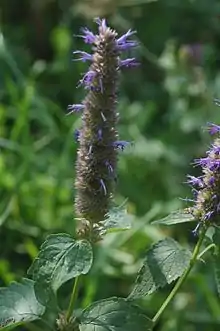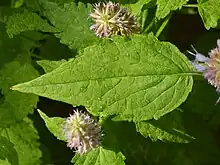Agastache rugosa
Agastache rugosa, also known as wrinkled giant hyssop,[3] Korean mint,[4] purple giant hyssop,[5][lower-alpha 1] Indian mint and Chinese patchouli is an aromatic herb in the mint family, native to East Asia (China, Japan, Korea, Russian Primorye, Taiwan, India, and Vietnam).[1]
| Agastache rugosa | |
|---|---|
 | |
| Scientific classification | |
| Kingdom: | Plantae |
| Clade: | Tracheophytes |
| Clade: | Angiosperms |
| Clade: | Eudicots |
| Clade: | Asterids |
| Order: | Lamiales |
| Family: | Lamiaceae |
| Genus: | Agastache |
| Species: | A. rugosa |
| Binomial name | |
| Agastache rugosa | |
| Synonyms[2] | |
| |
Description

A. rugosa is a perennial plant growing up to 40–100 cm (16–39 in) tall, with square stalks that branch at the upper part.[8] The oval-cordate leaves are oppositely arranged, 5–10 cm (2–4 in) long and 3–7 cm (1+1⁄4–2+3⁄4 in) broad, with coarsely serrated margins.[8] Some leaves have hair and/or touches of white on the underside.[8] The leaves are slightly larger than anise hyssop.[9]
From July to September in the Northern Hemisphere, purple bilabiate flowers bloom in verticillasters that are 5–15 cm (2–6 in) long and 2 cm (3⁄4 in) broad.[8] The calyx is 5–6 mm (0.20–0.24 in) long, with five narrow triangular lobes.[8] The petals are 8–10 mm (0.31–0.39 in) long, lower ones longer and the ones inside serrated. They range in color from rose to violet. The stamens are didynamous, long, and exposed.[8] The fruit is schizocarp, with obovate elliptical mericaps of 1.8 mm (0.071 in).
Cultivation
A. rugosa grows well in fertile, moisture-retentive soils and good sunlight. The aroma becomes weaker in shady conditions.[8]
The plant can be propagated by both sexual and asexual means. The seeds gathered in autumn can be sown in the spring. One can also dig out the plant in autumn or early spring, divide the roots, and plant them at intervals of 30 centimetres (12 in).
Cultivars
There several cultivars, including 'Golden Jubilee', which has yellow-green foliage,[10] 'Alabaster'[11][12] and 'Fragrant Delight'.[12] There are also a number of giant hyssop hybrids with A. rugosa as a parent, such as Agastache × 'Black Adder'[13] and 'Blue Fortune',[11] a Royal Horticultural Society Award of Garden Merit winner.[14]
Uses
Korea
The plant's Korean name is baechohyang (배초향), but it is more commonly known as banga (방아) in southern parts of Korea, where the herb is extensively cultivated and consumed. In southern Korean cuisine, the herb is a popular last minute addition to various dishes, such as chueo-tang (pond loach stew), and maeun-tang (spicy fish stew).[15] It is also sometimes used as the main ingredient in buchimgae (Korean pancakes).
China
It is called huòxiāng (Chinese: 藿香)[16] in Chinese and it is one of the 50 fundamental herbs used in traditional Chinese medicine. It is used interchangeably with guang huo xiang.[17] It was traditionally used to relieve nausea, vomiting and poor appetite. It contains methyl chavicol, anethole, anisaldehyde, limonene, pinene and linalool.[18]
Chemical constituents
Chemical compounds found in the plant include:[19]
- Estragole, plant
- p-Anisaldehyde, plant
- 4-methoxycinnamaldehyde,[20] shoot
- Pachypodol, leaf
- Methylchavicol (60.01–88.43%),
- d-Limonene
- Caryophyllene
- Hexadecanoic acid
- Linoleic acid
- Octahydro-7-methyl-methylene-4-(1-methylethyl)-1H-cyclopenta[1,3]cyclopropa[1,2]benzene[21]
Notes
- "Purple giant hyssop" also commonly refers to Agastache scrophulariifolia,[6] which A. rugosa is often misidentified as.[7]
References
- "Agastache rugosa". Germplasm Resources Information Network. Agricultural Research Service, United States Department of Agriculture. Retrieved 2008-02-19.
- "Agastache rugosa (Fisch. & C.A.Mey.) Kuntze". World Checklist of Selected Plant Families. Royal Botanic Gardens, Kew. Retrieved 19 April 2015 – via The Plant List. Note that this website has been superseded by World Flora Online
- Leon Carleton Snyder. Flowers for Northern Gardens. University of Minnesota Press, 1983. p. 71. ISBN 9781452902579
- English Names for Korean Native Plants (PDF). Pocheon: Korea National Arboretum. 2015. p. 343. ISBN 978-89-97450-98-5. Archived from the original (PDF) on 25 May 2017. Retrieved 22 December 2016 – via Korea Forest Service.
- Diana Stoll. "Agastache: An Herb for the Perennial Border." Llewellyn's 2019 Herbal Almanac: A Practical Guide to Growing, Cooking & Crafting. Llewellyn Worldwide, 2018. pna. ISBN 9780738756578
- Arthur O. Tucker and Thomas DeBaggio, The Encyclopedia of Herbs: A Comprehensive Reference to Herbs of Flavor and Fragrance. Timber Press, 2009. p. 127. ISBN 9781604691344
- Roger Guillermo Fuentes-Granados. "Genetic Studies of Agastache." Iowa State University PhD dissertation. 1997. p. 14. doi:10.31274/rtd-180813-13259
- "배초향" [Korean mint]. Korea Biodiversity Information System (in Korean). Korea National Arboretum. Retrieved 25 December 2016.
- Tucker, Arthur; Debaggio, Thomas. The Encyclopedia of Herbs. London: Timber Press.
- "Agastache rugosa 'Golden Jubilee'". rhs.org.uk. Retrieved 1 March 2023.
- Hanneke Van Dijk. Encyclopedia of Border Plants. Taylor & Francis, 1999. p. 30. ISBN 9781579582029
- List of names of woody plants and perennials. Retrieved 1 March 2023.
- "Agastache 'Black Adder'" at Missouri Botanical Garden Plant Finder. Retrieved 1 March 2023.
- "Agastache 'Blue Fortune'" at Royal Horticultural Society website. Retrieved 1 March 2023.
- 김, 민철 (20 October 2016). "향긋한 '토종 허브', 그 이름은 배초향" [Fragrant traditional herb, its name is baechohyang]. The Chosun Ilbo (in Korean). Retrieved 22 December 2016.
- Li, Xi-wen; Hedge, Ian C. "Agastache rugosa". Flora of China. Vol. 17. Retrieved 2008-02-19 – via eFloras.org, Missouri Botanical Garden, St. Louis, MO & Harvard University Herbaria, Cambridge, MA.
- "Agastache rugosa". Plants for a Future. Archived from the original on 3 March 2008. Retrieved 2008-02-14.
- Home Herbal: Cook, Brew & Blend Your Own Herbs. DK Pub. 2011. ISBN 978-0-7566-7183-9.
- "Species Information". Dr. Duke's Phytochemical and Ethnobotanical Databases. Archived from the original on 2020-09-20. Retrieved 2008-02-19.
- 4-Methoxycinnamaldehyde inhibited human respiratory syncytial virus in a human larynx carcinoma cell line Wang K.C., Chang J.S., Chiang L.C., Lin C.C. Phytomedicine 2009 16:9 (882-886)
- Chemical composition of essential oil in stems, leaves and flowers of Agastache rugosa Yang D., Wang F., Su J., Zeng L. Zhong yao cai = Zhongyaocai = Journal of Chinese medicinal materials 2000 23:3 (149-151)
External links
- Photo
 Media related to Agastache rugosa at Wikimedia Commons
Media related to Agastache rugosa at Wikimedia Commons Data related to Agastache rugosa at Wikispecies
Data related to Agastache rugosa at Wikispecies- Agastache rugosa in the CalPhotos photo database, University of California, Berkeley
- "Agastache rugosa". Plants for a Future.
- Medicinal Plant Images Database (School of Chinese Medicine, Hong Kong Baptist University) (in Chinese) (in English)
_leaves.jpg.webp)
_(Agastache_rugosa).jpg.webp)